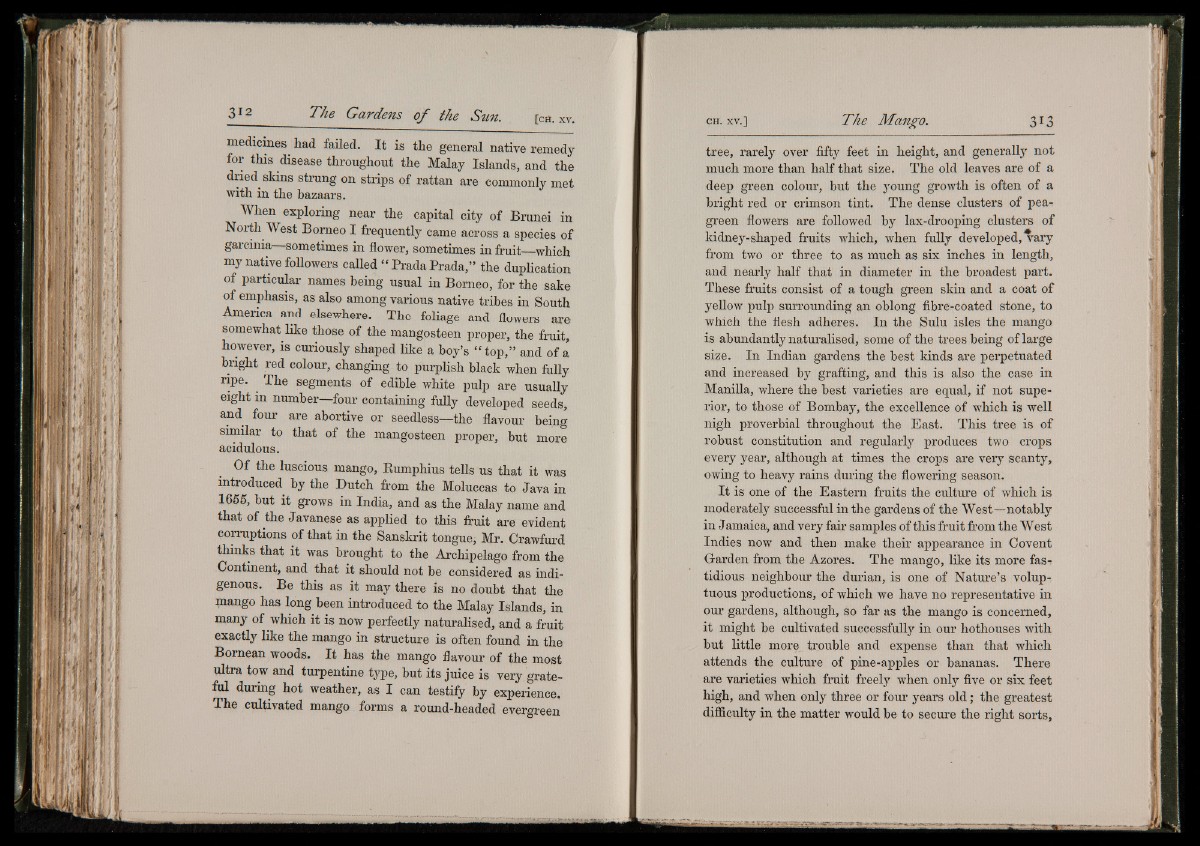
medicines had failed. It is the general native remedy
for this disease throughout the Malay Islands, and the
dried skins strung on strips of rattan are commonly met
with in the bazaars.
When exploring near the capital city of Brunei in
North West Borneo I frequently came across a species of
garcinia—sometimes in flower, sometimes in fruit—which
my native followers called “ PradaPrada,” the duplication
of particular names being usual in Borneo, for the sake
of emphasis, as also among various native tribes in South
America and elsewhere. The foliage and flowers are
somewhat like those of the mangosteen proper, the fruit,
however, is curiously shaped like a boy’s “ top,” and of a
bright red colour, changing to purplish black when fully
ripe. The segments of edible white pulp are usually
eight in number—four containing fully developed seeds,
and four are abortive or seedless—the flavour being
similar to that of the mangosteen proper, but more
acidulous.
Of the luscious mango, Rumphius tells us that it was
introduced by the Dutch from the Moluccas to Java in
1655, but it grows in India, and as the Malay name and
that of the Javanese as applied to this fruit are evident
conniptions of that in the Sanskrit tongue, Mr. Crawfurd
thinks that it was brought to the Archipelago from the
Continent, and that it should not be considered as indigenous.
Be this as it may there is no doubt that the
rnango has long been introduced to the Malay Islands, in
many of which it is now perfectly naturalised, and a fruit
exactly like the mango in structure is often found in the
Bornean woods. It has the mango flavour of the most
ultra tow and turpentine type, but its juice is very grateful
during hot weather, as I can testify by experience.
The cultivated mango forms a round-headed evergreen
tree, rarely over fifty feet in height, and generally not
much more than half that size. The old leaves are of a
deep green colour, but the young growth is often of a
bright red or crimson tint. The dense clusters of pea-
green flowers are followed by lax-drooping clusters of
kidney-shaped fruits which, when fully developed, vary
from two or three to as much as six inches in length,
and nearly half that in diameter in the broadest part.
These fruits consist of a tough green skin and a coat of
yellow pulp surrounding an oblong fibre-coated stone, to
which the flesh adheres. In the Sulu isles the mango
is abundantly naturalised, some of the trees being of large
size. In Indian gardens the best kinds are perpetuated
and increased by grafting, and this is also the case in
Manilla, where the best varieties are equal, if not superior,
to those of Bombay, the excellence of which is well
nigh proverbial throughout the East. This tree is of
robust constitution and regularly produces two crops
every year, although at times the crops are very scanty,
owing to heavy rains during the flowering season.
It is one of the Eastern fruits the culture of which is
moderately successful in the gardens of the West—notably
in Jamaica, and very fair samples of this fruit from the West
Indies now and then make their appearance in Covent
Garden from the Azores. The mango, like its more fastidious
neighbour the durian, is one of Nature’s voluptuous
productions, of which we have no representative in
our gardens, although, so far as the mango is concerned,
it might be cultivated successfully in our hothouses with
but little more trouble and expense than that which
attends the culture of pine-apples or bananas. There
are varieties which fruit freely when only five or six feet
high, and when only three or four years old; the greatest
difficulty in the matter would be to secure the right sorts,